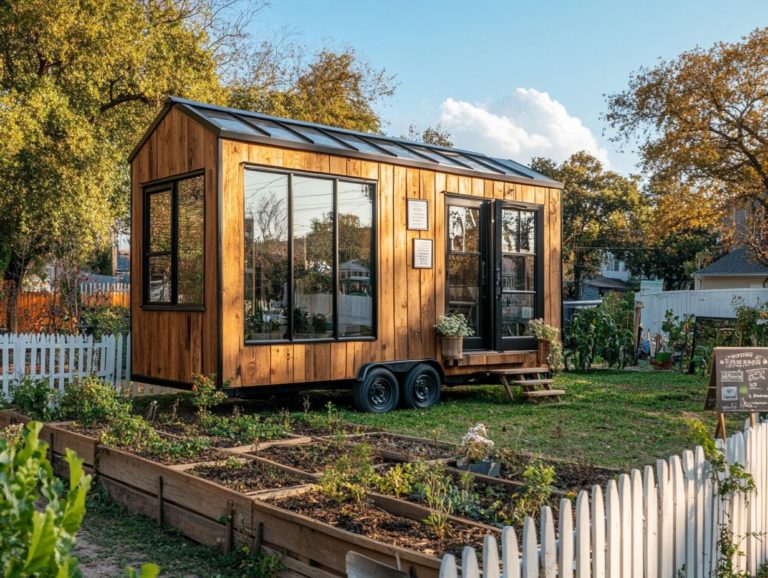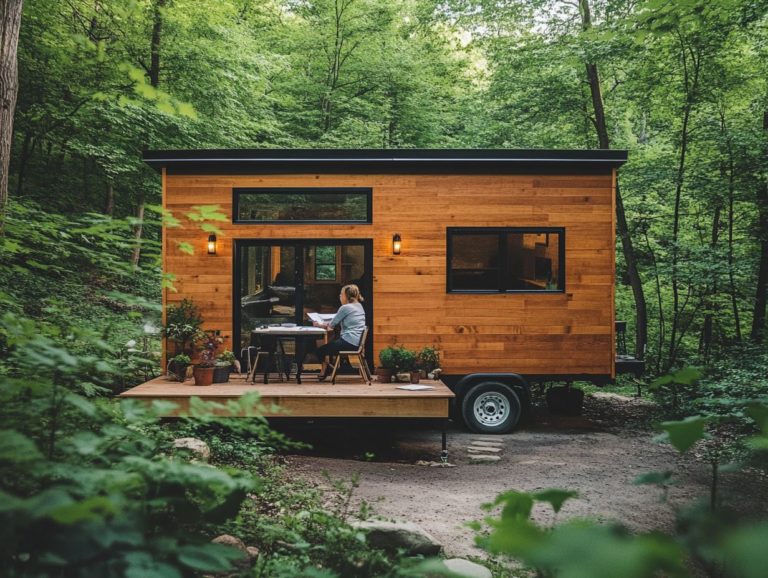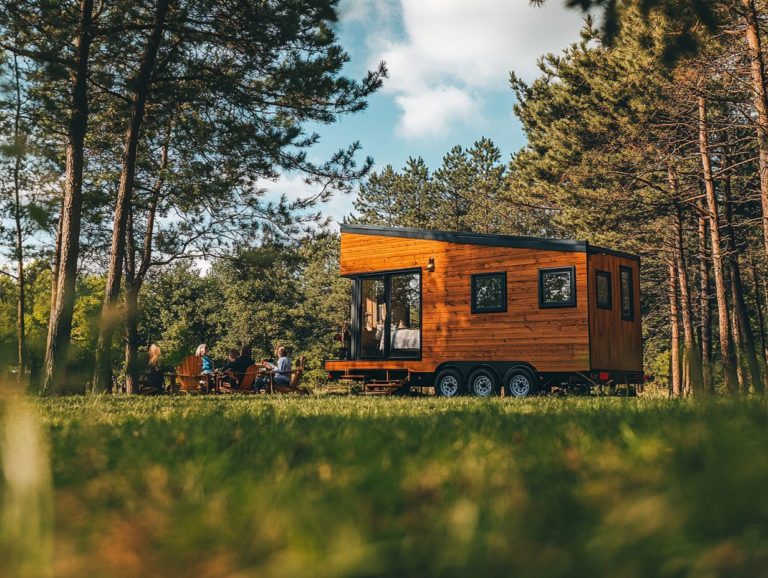The Impact of Local Laws on Tiny House Living
Tiny house living has undoubtedly captured your imagination, presenting a minimalist lifestyle that promises both freedom and sustainability.
Yet, this trend is not without its challenges. You’ll find yourself grappling with zoning laws, building codes, and the intricate web of permits and parking regulations. For prospective tiny house dwellers, the legal landscape is rife with hurdles that require careful navigation.
Let s dive into the exciting world of tiny house living, exploring the challenges and triumphs of its residents!
Contents [hide]
- Key Takeaways:
- Understanding Tiny House Living
- The Legal Landscape of Tiny House Living
- Challenges Faced by Tiny House Dwellers
- Frequently Asked Questions
- How do local laws affect your tiny house dreams?
- What are some common restrictions that local laws may impose on tiny house living?
- Do local laws differ from place to place when it comes to tiny house living?
- How can I find out about the local laws that affect tiny house living in my area?
- What should I do if the local laws in my area don’t allow for tiny house living?
- Are there any resources available to help navigate the impact of local laws on tiny house living?
Key Takeaways:
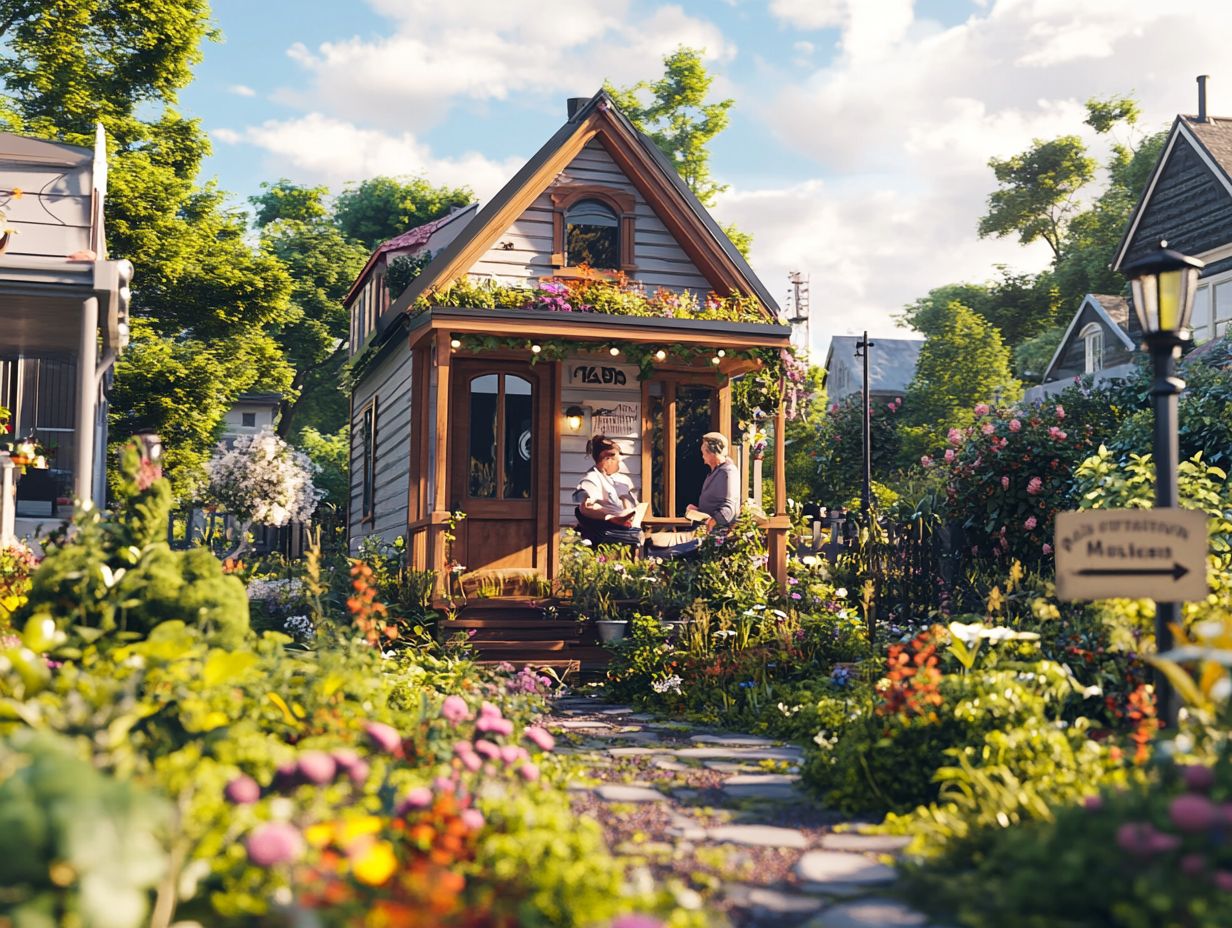
- Tiny house living is gaining popularity, but faces challenges due to varying local laws and regulations.
- Zoning laws, building codes, and permitting regulations greatly affect the feasibility of living in a tiny house.
- Efforts to legalize tiny houses and create suitable communities are underway, but more advocacy and change is needed for widespread acceptance.
Understanding Tiny House Living
Understanding Tiny House Living invites you to explore the vibrant Tiny House Movement. This movement has surged in popularity as individuals and families pursue affordable housing options that emphasize simplicity and sustainability.
It has led to the establishment of numerous tiny house communities nationwide. Here, residents relish the advantages of smaller living spaces while cultivating a genuine sense of belonging.
By diving into the allure of tiny homes, you can discover how their thoughtful design promotes minimalism and mindful living. These homes function as small houses that can be built on existing properties while adhering to local building codes.
Defining Tiny Houses and Their Popularity
Tiny houses, typically defined as homes under 400 square feet, have found their moment in the spotlight, thanks to the Tiny House Movement. This movement supports a simpler lifestyle focused on affordability and sustainability. It provides potential homeowners a way to live economically.
These compact havens attract a broad spectrum of individuals, from millennials chasing financial independence to retirees looking to simplify their lives. Their charm lies not only in reduced construction and maintenance costs but also in the chance to embrace more sustainable living choices.
With their minimalist designs and clever use of space, tiny houses inspire you to prioritize experiences over possessions. As interest in minimalism and environmental awareness continues to rise, the allure of these homes grows even stronger.
In an age where cultural values are shifting towards intentional living and community over consumption, tiny houses have become a fashionable choice for those seeking a more meaningful lifestyle, particularly in states like Colorado and California.
The Legal Landscape of Tiny House Living
Navigating the legal landscape of tiny house living requires a keen understanding of the myriad laws and regulations that vary significantly from one region to another. You’ll need to familiarize yourself with building codes and zoning regulations that determine where and how you can position your tiny house on wheels especially in Alabama or California.
This knowledge is essential for making informed decisions and ensuring that your tiny living experience is both enjoyable and compliant with local zoning laws.
Ready to explore tiny house living? Join the movement today!
Zoning Laws and Building Codes

Zoning laws and building codes play a pivotal role in your tiny house journey. These rules greatly affect where you can put your tiny home and determine not only the legality but also the practicality of tiny homes in various locations. They are often shaped by standards set forth in the International Building Code and International Residential Code, which are critical for tiny house owners.
You might face many different rules that vary dramatically from one region to another. In “tiny house friendly” areas, local governments are more inclined to relax zoning restrictions, encouraging community building and innovative living solutions. Understanding the importance of community rules in tiny house living can help navigate these variations effectively.
However, not every state rolls out the welcome mat for tiny homes. California, for instance, has numerous local jurisdictions that actively support tiny housing initiatives and often designate specific areas for placement. In contrast, Alabama may enforce stricter regulations, confining tiny house developments to recreational vehicle parks or similar zones.
Understanding these differences is essential for your tiny house journey. Before you make the leap into tiny house ownership, consider exploring the impact of tiny house communities on local economies and dive into your local codes today!
Permitting and Parking Regulations
Permitting and parking regulations are crucial considerations for you as a tiny house owner, especially if you’ve chosen to live in a tiny house on wheels. Permitting refers to the official approval needed to build or place your tiny house. These regulations dictate where you can legally park and what permits you need for construction.
Understanding the distinctions between stationary and mobile tiny homes is vital for your planning. Each type comes with its own set of permits and approvals. If you own a stationary unit, you ll likely need building permits, zoning permits, and possibly even septic permits, which are necessary if your home will not be connected to a public sewer system.
On the other hand, if your tiny home is mobile, you ll need a different array of permits, including vehicle registration and specific road permits for travel. Local zoning departments play a key role in enforcing these regulations and can significantly influence where you can legally place your tiny house.
Take, for instance, states like Oregon and Texas, where tiny home advocates have successfully collaborated with zoning boards to establish designated tiny home communities. Act now to understand tiny house zoning laws and secure your tiny house dream!
Challenges Faced by Tiny House Dwellers
Tiny house dwellers frequently encounter a range of challenges. You may find yourself grappling with legal hurdles while navigating the intricate maze of tiny house regulations. Finding land or communities that welcome tiny houses can be tough.
Navigating Legal Hurdles
Navigating the legal hurdles of tiny house living requires you to grasp the intricacies of local zoning regulations and tiny house laws, which can differ widely from one municipality to another.
For many aspiring tiny house owners, this involves actively engaging with local zoning departments to clarify what is permissible. Researching specific zoning ordinances is essential, as factors like minimum square footage requirements or restrictions on mobile homes can present significant challenges. Understanding the importance of zoning in tiny house living can help navigate these issues more effectively.
Building positive relationships with local officials can be incredibly advantageous; they often hold valuable insights into potential loopholes or forthcoming changes in regulations. By reaching out to the community, you can significantly enhance acceptance. Tiny house advocates can host informative sessions that showcase the benefits of tiny living and rally support from neighbors. This grassroots effort can pave the way for more favorable regulations over time.
Finding Suitable Land and Communities
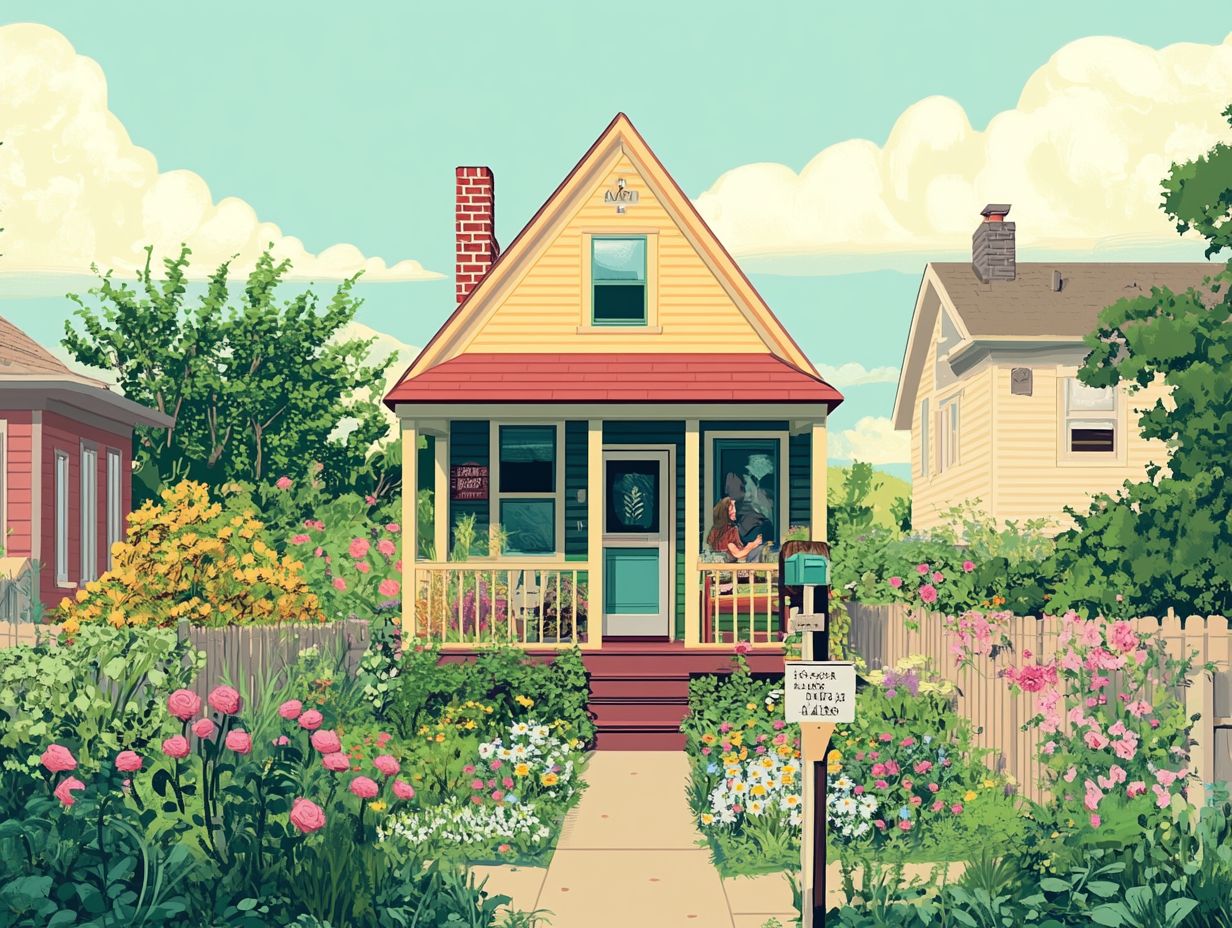
Finding the right land and communities for your tiny house can feel like navigating a maze. Zoning rules can really complicate your plans.
To tackle these challenges, explore tiny house communities or co-housing arrangements. These options provide shared resources and create a supportive living environment that makes your transition smoother.
Many of these communities have specific guidelines that accommodate smaller living spaces while fostering a sense of belonging among residents.
Engaging with successful initiatives like MeetUp groups and social media communities can connect you with potential tiny house owners. They can share valuable insights and firsthand experiences.
Resources like Tiny House Listings and local zoning boards can offer essential information about land availability and regulatory compliance. This will help you in your quest for a welcoming place to call home.
Advocating for Change
Advocating for change in tiny house regulations is crucial. More people and communities are recognizing the need for tiny house-friendly policies and supporting the Tiny House Movement’s vision for affordable living.
This shift is an exciting movement! It acknowledges the diverse and innovative solutions that tiny homes can offer for sustainable and accessible housing, especially in regions embracing the Tiny House Movement.
Efforts to Legalize Tiny Houses
Numerous initiatives are underway to legalize tiny houses. The focus is on changing strict rules and engaging local zoning departments to create a welcoming environment for tiny house owners.
Across the nation, advocates and community leaders are collaborating on innovative campaigns. They aim to reshape public perception and local policies surrounding tiny living.
For example, in Oregon, a grassroots initiative has successfully influenced state legislation to permit tiny homes in various zoning districts. This provides a model that others can emulate.
In Colorado, urban planners are teaming up with tiny house communities to establish pilot programs. They demonstrate how seamlessly these residences can integrate into existing neighborhoods.
Through these combined efforts, stakeholders highlight the importance of community input, educational workshops, and partnerships with local governments. All are aimed at fostering sustainable living environments for those pursuing a minimalist lifestyle.
Successful Examples of Tiny House Communities
Successful examples of tiny house communities illustrate the remarkable potential of affordable housing solutions that embrace the principles of the Tiny House Movement. These communities thrive in places like Colorado.
In these vibrant enclaves, residents enjoy cost-effective housing and cultivate a profound sense of belonging. This sense of community is vital for community resilience.
With a focus on sustainability and shared spaces, these communities often feature gardens, communal areas, and eco-friendly amenities. This creates dynamic settings for interaction and collaboration.
Innovative local policies have paved the way for these neighborhoods. This shows that legislative challenges can be overcome for the greater good. As other regions take note of these successful models, there is a compelling opportunity for you to replicate such initiatives. This addresses housing shortages and champions environmental stewardship.
Frequently Asked Questions
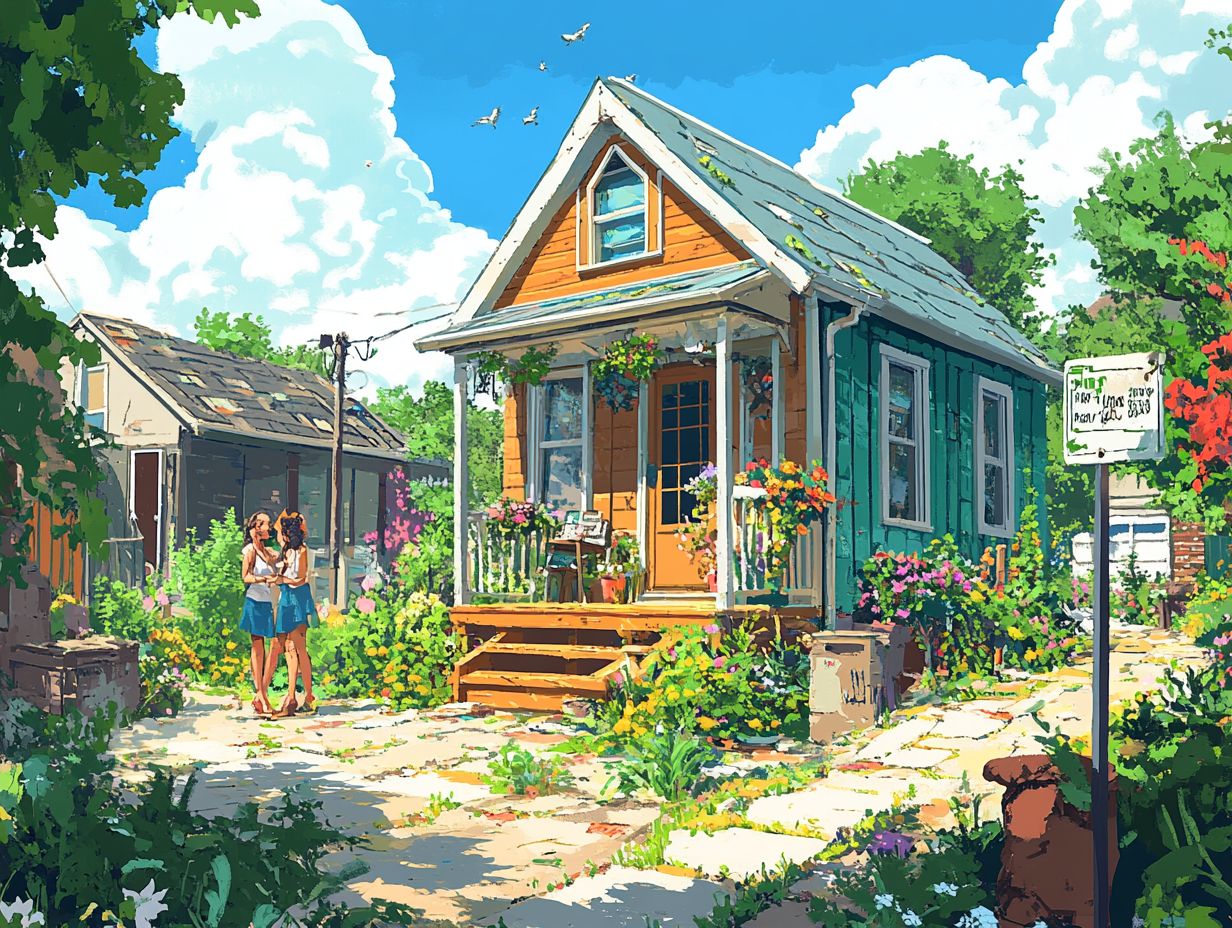
How do local laws affect your tiny house dreams?
Local laws are regulations set by city or county governments. They dictate what can and cannot be done in a particular area, which can directly impact tiny house living by restricting the size, location, or ownership of tiny homes.
Ready to explore your tiny house options? Join a community, check local laws, and take the next step toward your tiny house dream!
What are some common restrictions that local laws may impose on tiny house living?
Local laws often set rules on the size of tiny homes. They may specify a minimum square footage or require a certain number of rooms.
Do local laws differ from place to place when it comes to tiny house living?
Yes, regulations can vary widely between cities and counties. Some areas may welcome tiny homes, while others may have strict rules or even bans.
How can I find out about the local laws that affect tiny house living in my area?
To discover local laws, contact your city or county government directly. They’ll have the answers you need about zoning and building codes.
What should I do if the local laws in my area don’t allow for tiny house living?
If local laws prevent tiny house living, consider advocating for change. Work with local officials or join a community of tiny house supporters to push for policy updates.
Are there any resources available to help navigate the impact of local laws on tiny house living?
Yes! You can access various resources like legal advice from attorneys who specialize in tiny house regulations. Online communities and advocacy groups can also offer valuable support.

